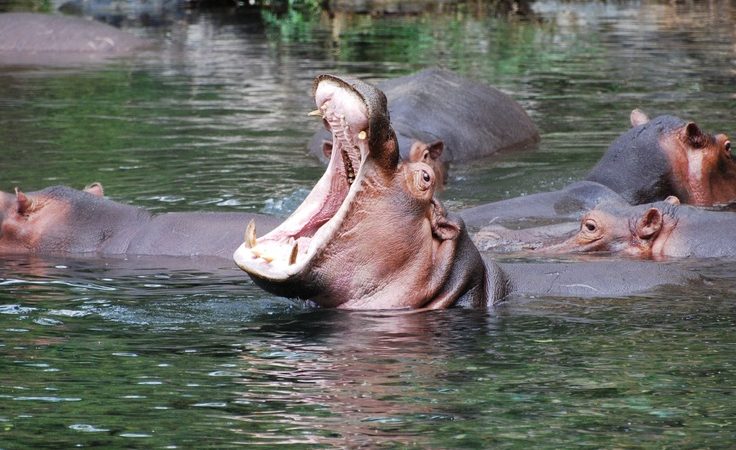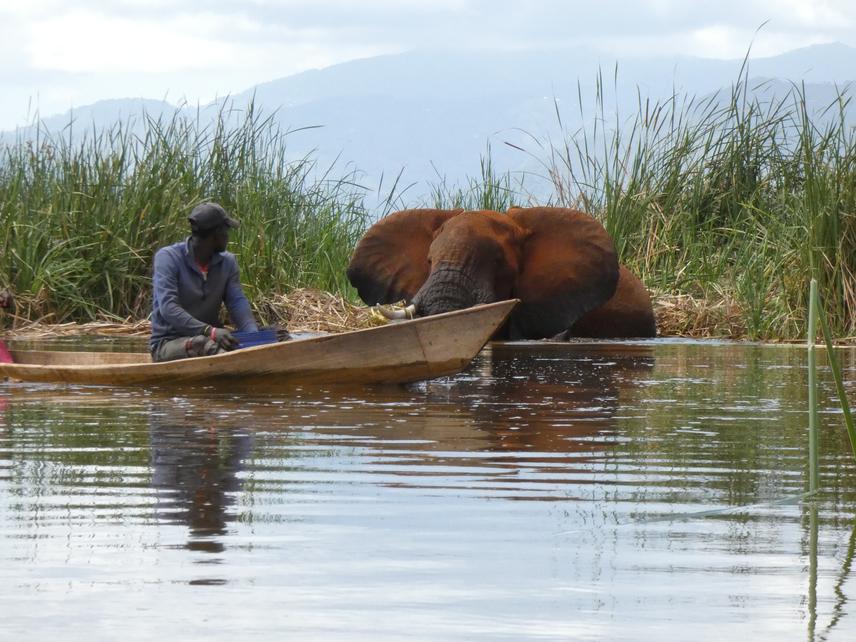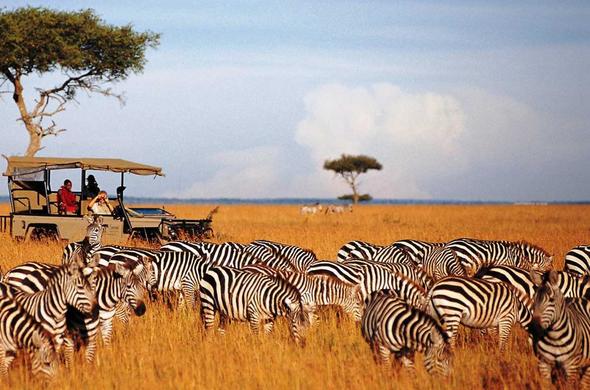The 10 Best National Parks in Kenya that are A must see
The very best of Kenya national parks and game parks are spread Kenya is blessed with some of the best national parks ideal for 1 or 2- week family safari. If you love watching wildlife in the wilderness and love to see scenic areas with majestic plains, mountains, rivers and lake, then these 10 parks in Kenya are your best for a family holiday safari.
1. Masai Mara
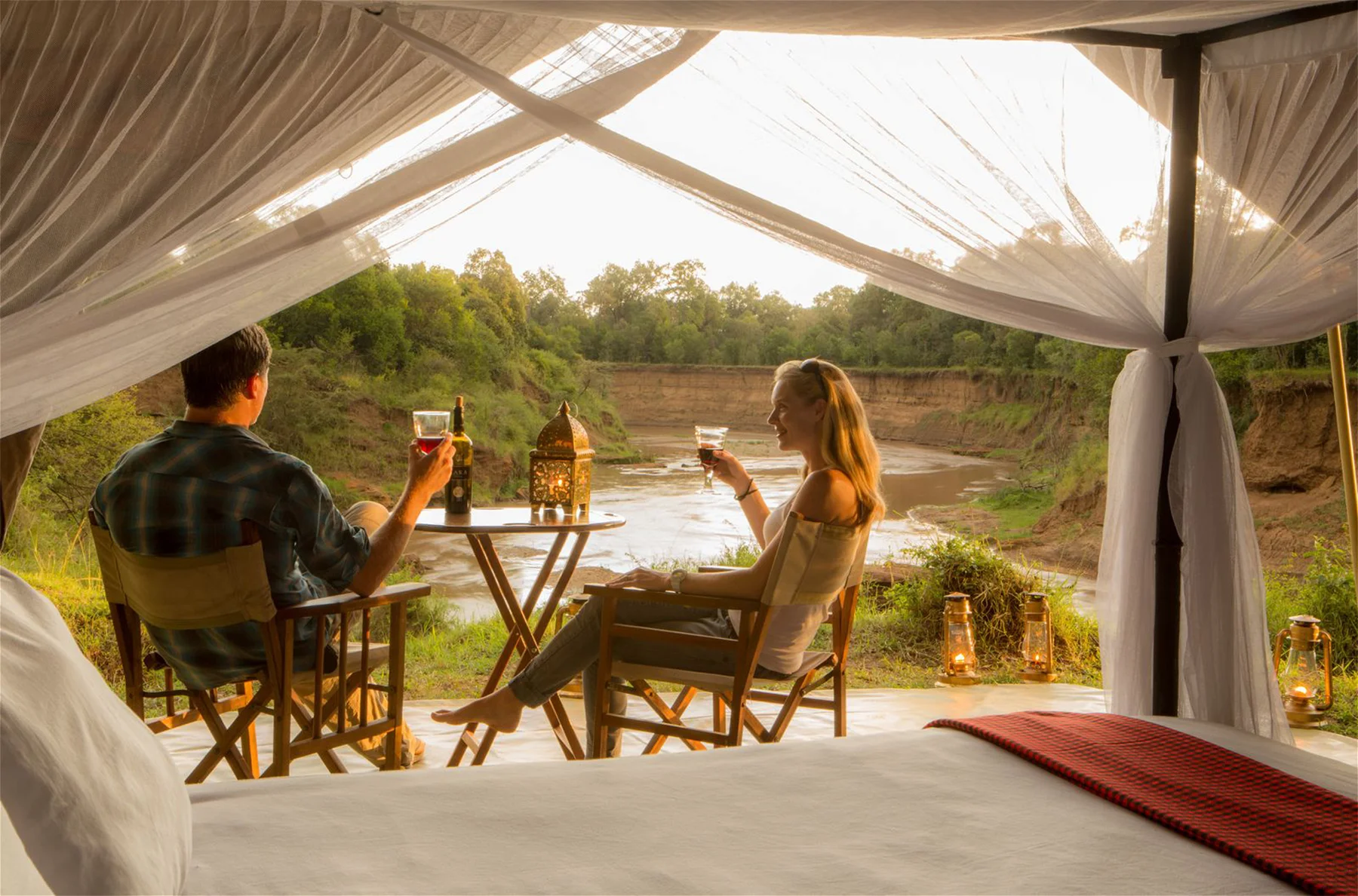
One of the greatest places to watch amazing numbers of wildlife in Africa is undoubtedly the Masai mara national reserve. This park boasts the widest open grasslands with the highest abundance of game. The mara is estimated to be home to over 5 million animals.
In what looks like unending undulating plains filled with thousands of animals, the Masai mara hosts the highest numbers of big cat predators. This 1510 square kilometers national park is located south west of Nairobi city along the border with Tanzania.
Masai mara is also home to more than 500 species of birds. The annual wildebeest migration that happens every July to November brings along 1.5 million wildebeests, zebras and antelopes. This great wildebeest migration climaxes at the mara river crossing when thousand cross the swollen river full of crocodiles.
This park remains to be the most visited national park in Kenya due to its large numbers of animals, scenic sites and the Masai people.
Best Time to Go: July – October
Top Attractions: Mara River crossing, The undulating Pains, The big Five, The ugly Five, Wildebeest Migration
Best Experiences: Hot air Balloon ride, game driving, migration tracking, Luxury Camping, Relaxing Sunsets
Accommodations to Stay & Eat: Governors camp, mara Serena lodge, Sarova mara, mara Sopa lodge,
How to Get There: You can take scheduled flight from Wilson airport Nairobi and land at airstrip near your lodge. A 4×4 jeep drive from Nairobi takes 5-6 hours.
2. Amboseli National Park
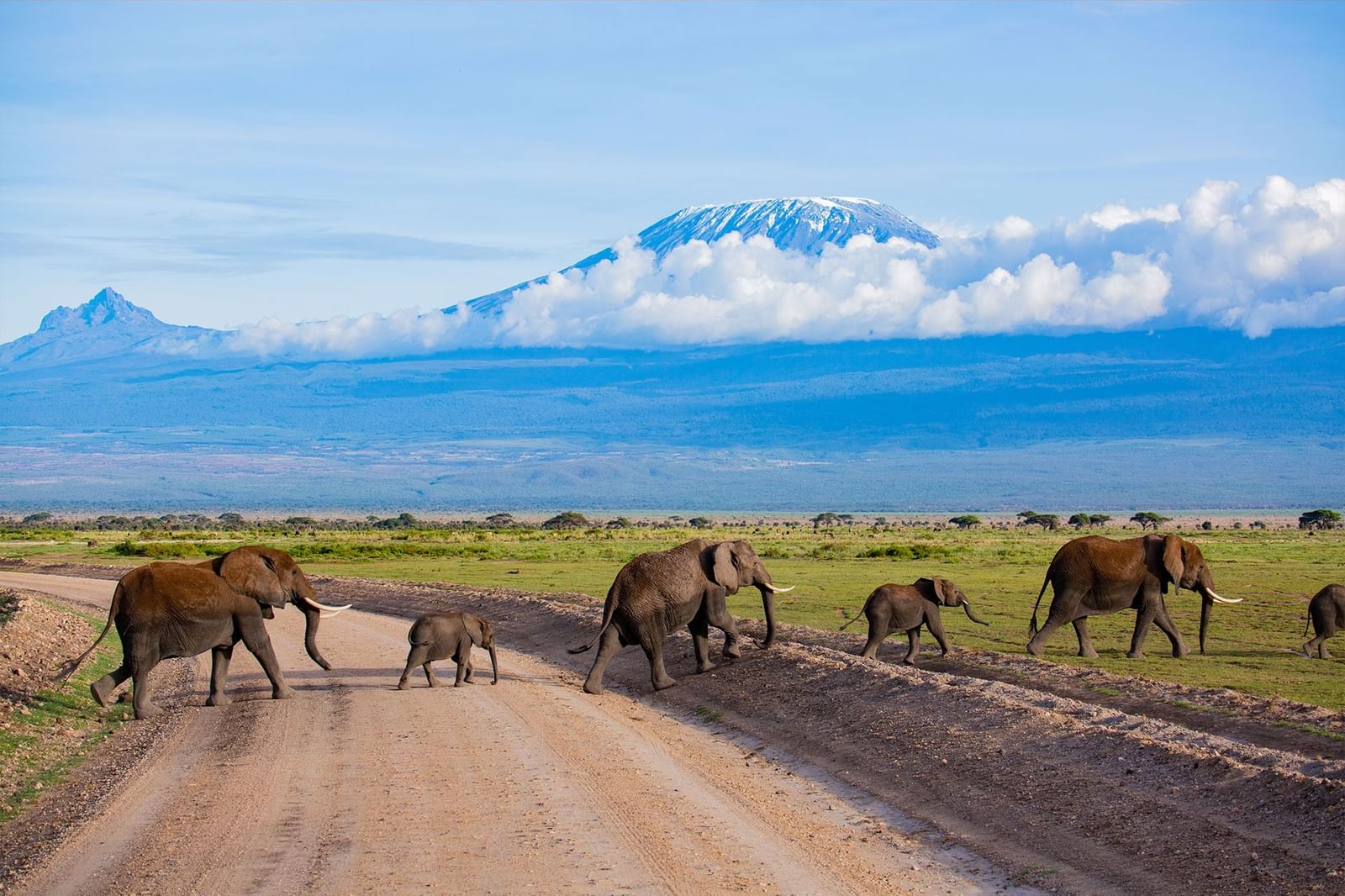
Known for its largest herds of wild African elephants, the Amboseli national park is located some 238km south east of Nairobi city. This park is one of the top national parks in Kenya for a family vacation. With an area of only 392 sq km, Amboseli national park is among the smaller parks in the country.
Its location below Africa’s highest mountain, the Mt Kilimanjaro, Amboseli also benefits from some of the most iconic backgrounds from wildlife photography. There are also more than 1700 elephants which can be seen all over the park.
Amboseli national park is one of the best game parks in Kenya due to its best views of Mt Kilimanjaro and the wildlife that include hippos, elephants, lions, buffalos, giraffes, gazelles, wildebeest, hyenas, impalas, cheetahs, leopards and many more.
For visitors in Nairobi who have a day to spare or a long layover at Nairobi international JKIA airport, Amboseli is a great choice for a day trip from Nairobi. The park also has some of the most scenic swamps that are fed from millions of gallons of meted ice waters from the Kilimanjaro.
Best Time to Go: July to October and December to March
Top Attractions: View of Mt Kilimanjaro, 1700 Herds of elephants, Big Four, Hippos, Masai Villages,
Best Experiences: Game drives, Dawn and sunset views of Kilimanjaro peak, Camping, Masai Dances
Accommodations to Stay & Eat: Amboseli Serena lodge, Amboseli Sopa, Ol Tukai Lodge
How to Get There: Take a 45 minute flight from Wilson airport to the amboseli airstrip, A drive in a 4×4 jeep takes 3 and a half hours via Mombasa road.
3. Tsavo National Park
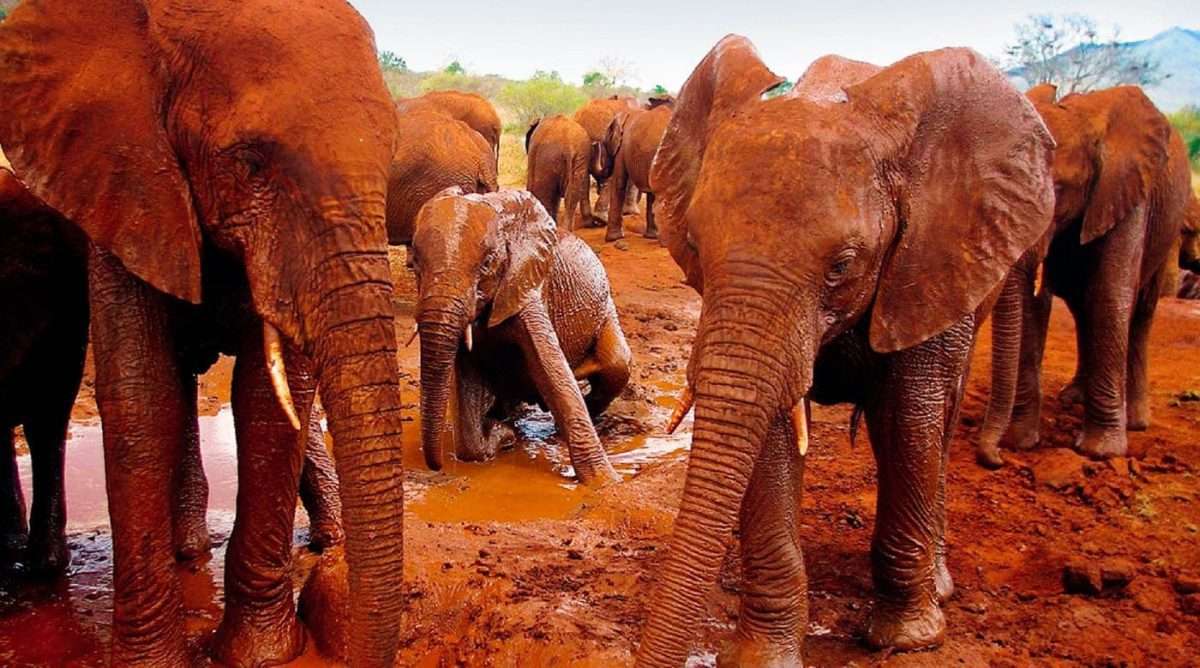
Due to its proximity to the Kenyan coast, Tsavo receives the highest number of tourists per year. Most of Kenya’s tourism happens at the coast and these volumes trickle down into Tsavo east national parks. Visitors at the coast will usually do a day trip, 2 days or a 3-day safari to the Tsavo. This park is divided into Tsavo west and Tsavo east national parks for administrative purposes.
Tsavo east national park is 13,747 sq km in size and is the largest park. The biggest attractions in Tsavo east are the Mudanda rock, the Galana river and the red-coloured elephants. Their colour comes from the red soil of this park with which they cover themselves
Tsavo West has a land area of 9,065 sq km is most popular for the crystal-clear water ponds that are home to crocodiles and hippos. The park also has a lava flow and caves and some of the most scenic forested areas. In terms of vegetation, tsavo west is denser than Tsavo east which is abit drier in vegetation.
Best Time to Go: June to October and January to March
Top Attractions: Mudanda rock, Galana River, Red elephants, Aruba waterhole, Big Five, Mzima Springs, Shetani lava Flows, Ngulia mountains, Ngulia rhino sanctuary,
Best Experiences: Long game drives, Luxury camping, underwater glass observation chamber
Accommodations to Stay & Eat: Kilaguni Serena lodge, voi wildlife lodge, voi safari lodge, Ashnil Aruba
How to Get There: Take a chartered 1 hr flight from Wilson airport Nairobi and land on tsavo east or tsavo west airstrips. A 4×4 landcruiser tour van takes you 5 hours to get there.
4. Mt Kenya National Park
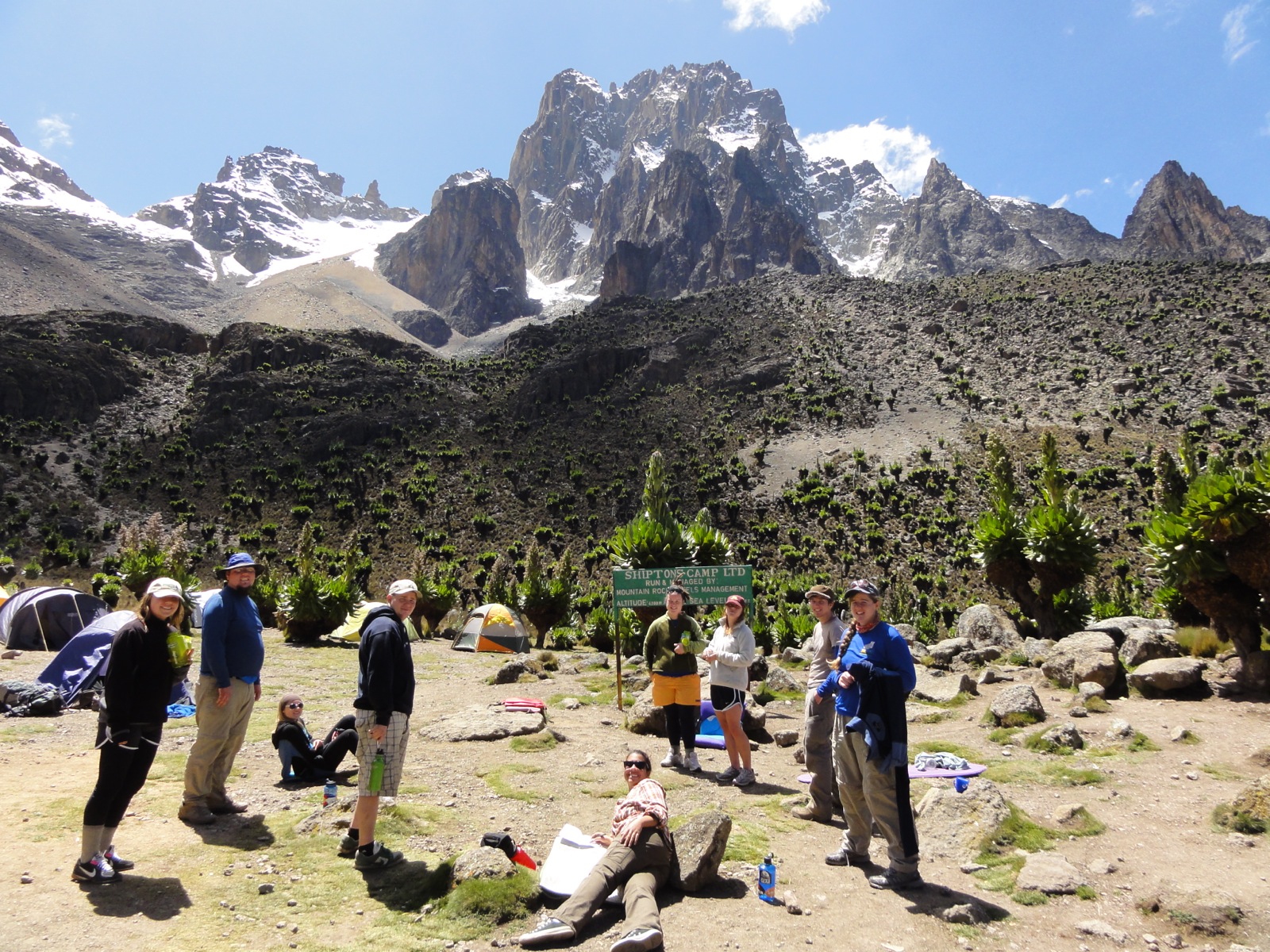
Host to Africa’s second highest mountain, Mt Kenya national park is among the top 10 national parks in Kenya. This park is located some 175km North of Nairobi city in the lush green kikuyu people highlands. It is centrally located in the middle of Kenya and is frequented by visitors visiting the Kenyan North from Masai mara or Nakuru.
The mountain stands at 5199meteres above sea level and is only second from Kilimanjaro at 5895m asl. Mount Kenya national park is the most visited park for mountain climbing in Kenya since it’s the highest in the country. It offers technical and leisure climbing routes with each of varying difficulty levels.
The hike to the Batian summit can be done from Sirimon, Chogoria and Naro Moru hiking routes. Naro Moru is the most challenging and Chogoria route is the most scenic. A full hiking trip to mt Kenya takes 6-7 days inclusive of an acclimatization day before the hike.
The park is also a popular day trip destination for hiking excursions from Nairobi city.
Best Time to Go: January to March and June to October
Top Attractions: Views of Peak Nelion, Lenana and Batian, Rain forest, Elephants, leopards, hogs, waterbucks, rhinos, alpine savannah, rock and ice.
Best Experiences: Hiking to peak Batian, fresh mountain air, majestic views, camping on the mountain, game viewing and bird watching.
Accommodations to Stay at & Eat: Fairmont Mt Kenya safari club, Meru Bandas, Mt Kenya Lodge, Serena Mountain Lodge, Old Moses mountain hut, Met Station Cabins,
How to Get There: You can connect by flight from Wilson airport to Nanyuki airstrip and then drive to the park. A 3hour drive from Nairobi is also more scenic.
5. Samburu National Reserve
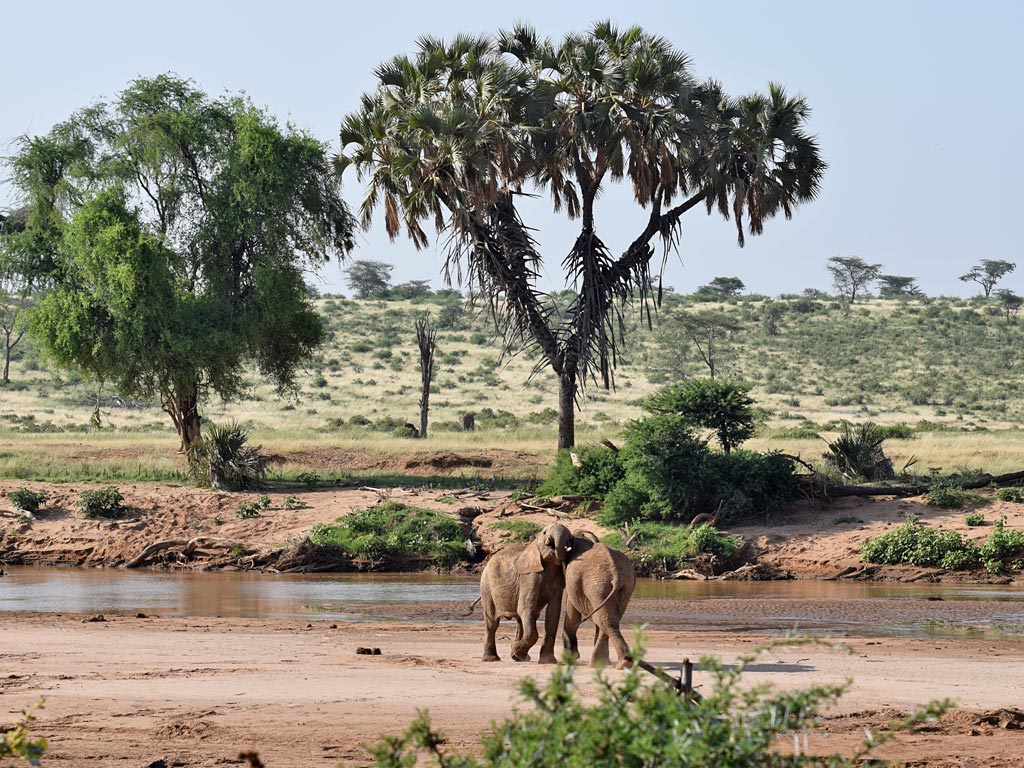
An absolute marvel of a park with its contrasting landscapes and unique species of wildlife from those found in the south. Samburu national reserve holds the mantle for the most dramatic park in terms of variety of landscapes. The park has blue mountain ranges and yellow and white dry sandy ground with scattered acacia shrubs.
The river Ewaso Ngiro provides a welcome relief of the dry vegetation with its green riverine trees and bushes that snakes around the middle of the dry valleys. This river cuts deep and artistic rock formations as it flows south east into Shaba national park.
Wildlife here can be found at midday as they come to take their daily drink of the water. Crocodiles are always hiding in crevices on the river bank ready to pound on inattentive antelopes.
Samburu is however known for its unique wildlife referred to as the unique five. These include the Bigger and round eared Grevy zebra, the Blue necked Somali ostrich, the beautifully coated reticulated giraffe, the long-necked gerenuk antelope, the Beisa Oryx with its long horns.
Samburu has some of the absolutely beautiful luxury tented camps along the Ewaso Ngiro river where elephants occasionally come to say hi.
Best Time to Go: July – October
Top Attractions: Special five wildlife (Beisa oryx, Somali Ostrich, Gerenuk, Reticulated Giraffe, Grevy Zebra), Scenic contrasting landscapes, ewaso ngiro river, Samburu culture, river game drives,
Best Experiences: Game drives by river ewaso, Camping and lodge relaxation, walking safaris, birding tour, river beach breakfasts and dinners, Samburu village visits.
Accommodations to Stay & Eat: Serena Samburu, Sarova Shaba, Samburu lodge, Samburu Sopa, Ashnil samburu,
How to Get There: Fly into samburu airstrip from Nairobi Wilson airport, a flight of 1hr 8 minutes. You can also drive the 221km from Nairobi to samburu by 4×4 jeep for 6 hours.
6. Lake Nakuru National Park
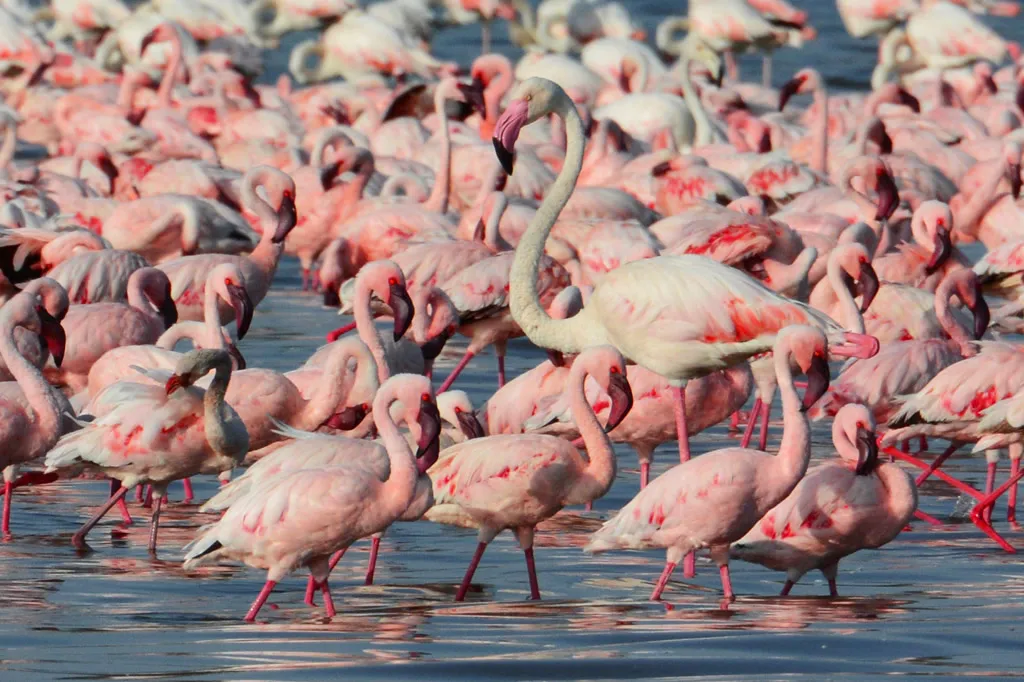
Located on the floor of the great rift valley, lake Nakuru national park is among the 10 best game parks in Kenya. This 177 sq km wildlife park is located on the floor of the great rift valley and is home to a large lake that takes two thirds of the area.
This park is home to over 400 species of birds among them the flagship flamingo which number in excess of 2 million individuals. The flamingos are so many that they form a wide pink ribbon around the shores of the lake where they feed on algae.
This park’s close proximity to Nairobi city at only 160km (2.5hrs) makes it very attractive and one of the most visited national parks in Kenya. The lake forms a great game drive circuit where you will see the hippos, rhinos, giraffes, leopards, lions, buffalos, stripped hyenas, klipspringers (type of rock dwelling antelope) and many more.
Nakuru has the best sightings for the white and black rhinos and leopards that love to walk along the game drive tracks. You may drive side by side with the leopards or find it perched in an acacia tree just next to the game drive track.
Lions of lake Nakuru are known for climbing trees for God knows what reason.
Best Time to Go: June to March
Top Attractions: Lake Nakuru, Big four animals, Baboon cliff, Makalia falls, Millions of flamingos, over 500 species of birds, great lodges and camps,
Best Experiences: Game drives, exciting views of the lake and bird life, panoramic views from baboon cliff,
Accommodations to Stay & Eat: Sarova lion hill, nakuru Sopa lodge, lake nakuru lodge, The cliff
How to Get There: You can take a flight from Wilson airport to the parks airstrip. Alternatively drive the 2 and a half hours by road.
7. Nairobi National Park
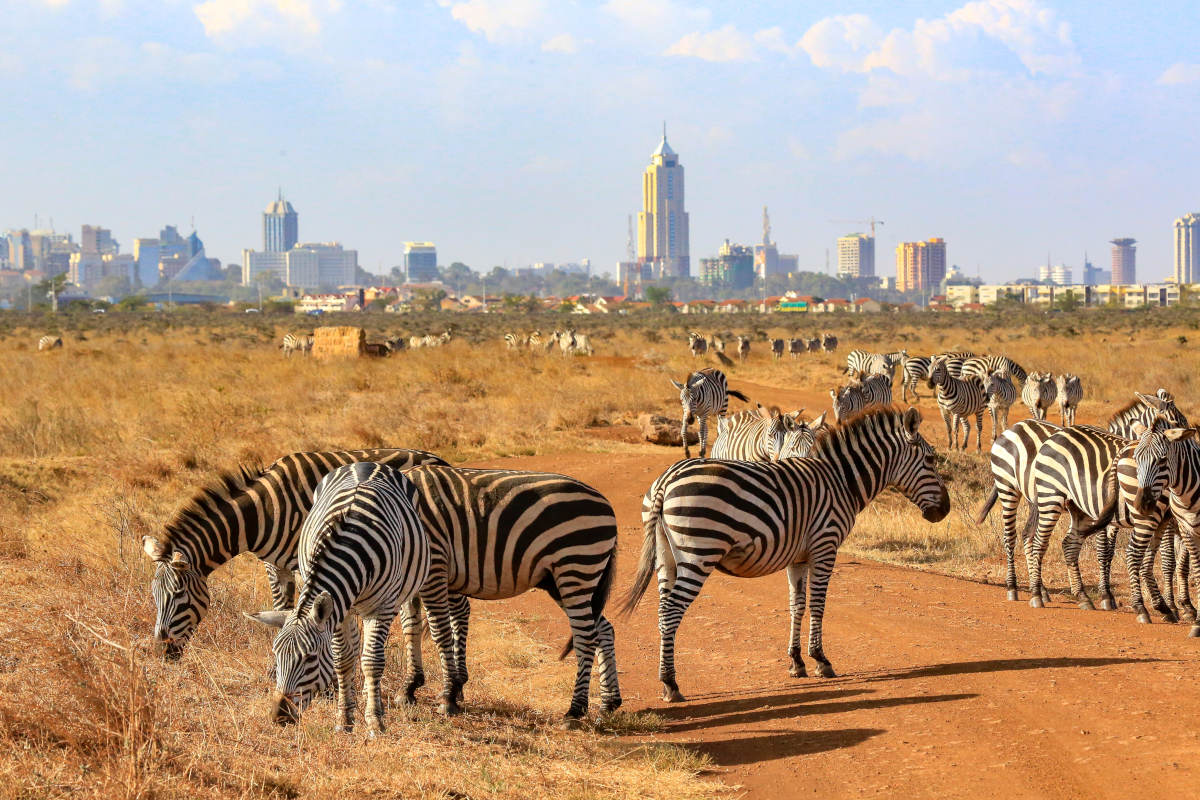
One of the most convenient parks in Kenya is the Nairobi national park. Located only 7km from the Nairobi city CBD, the park is only 10 minutes away from most hotels in the city. This 117sqkm park is the only national park located inside the boundaries of a capital city in the world.
Nairobi Park makes Nairobi to be known as the wildlife capital of the world. This park shares space with the city’s buildings that occasionally you have lions roaming the major outbound highways. A local university next to the park is famous for its nightly alarms of a prowling lion or leopard at night.
Besides the elephants, Nairobi national park has most of the big five animals. The elephants are however such destructive feeders that they cannot be sustained in this park. However, the park is home to lions, rhinos, buffalos, giraffes, hippos, crocodiles, impalas, elands, wildebeests, hartebeests, leopards, cheetahs, gazelles, jackals, zebras, hyenas, baboons and many others.
One of the greatest shots is a giraffe or a rhino in the foreground and the city’s skyscrapers forming your background. It’s the only park in the world that you can strike a shot that is a mix of nature in its rawest form and modernity.
The biggest advantage of Nairobi national park however is its ability to provide you with an escape from the hustle and bustle of the city and experience the silence and peace of nature only 10 minutes away.
Best Time to Go: July to October
Top Attractions: Ivory burning monument, hyena dam, view point, Mokoiyet valley, Mbagathi river trail, Athi dam, big four animals,
Best Experiences: 4 hour game drive in the morning or evening, Bird watching, walking trail by the river
Accommodations to Stay & Eat: Most hotels in Nairobi city, Ololo, masai lodge, Nairobi tented camp
How to Get There: Drive for 10 minutes from most of the hotels in Nairobi city. Park is only 7km from Nairobi CBD.
8. Aberdare National Park
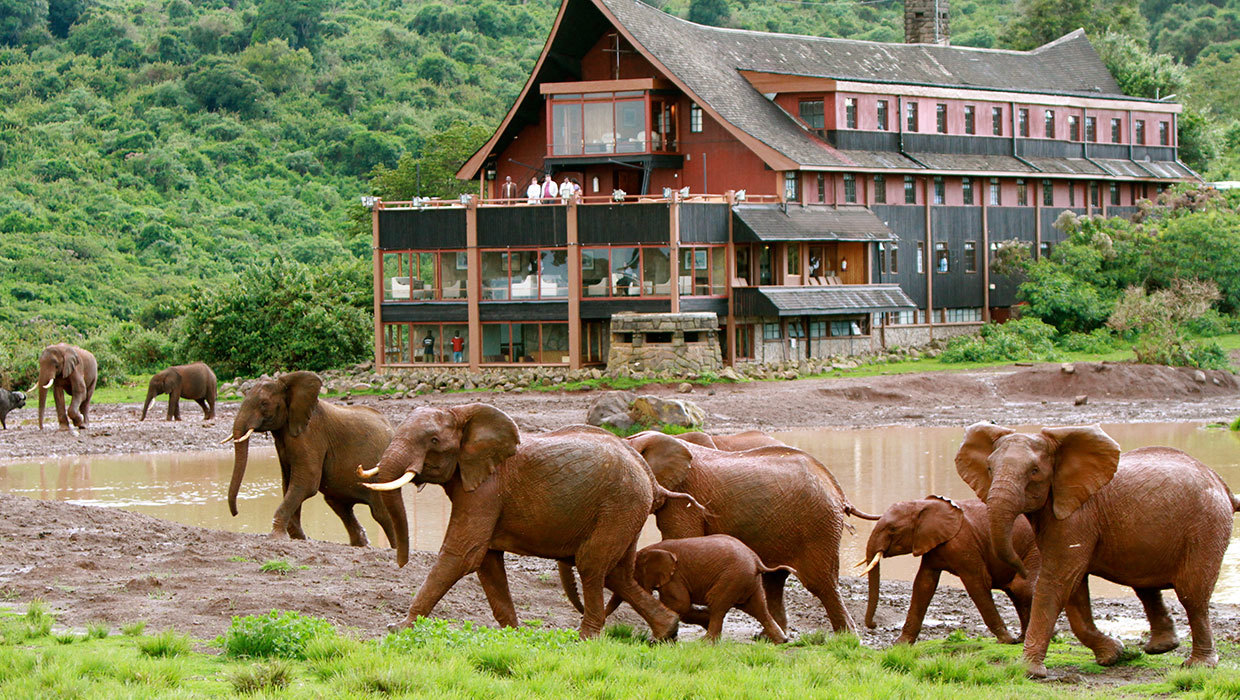
For the nature walk lovers, this park is your best bet for hiking and camping. The Aberdare national park is the space around a range of mountains that stretch through 4 counties. The Aberdare range park is famous for its scenic alcoves, alpine streams and deep rain forest with cool breeze and wet weather.
Measuring 767sqkm in area, the Aberdare is composed of dense rain forest from the gates up to the bamboo forest level. This gives way to the alpine moorland or alpine savannah. This is where most of the streams emanate from before joining up to become larger rivers by the time they exit the park.
The most common activity in Aberdare include hiking, camping, trout fishing and game viewing. Due to the forested nature of the park viewing of wildlife is best done from lodge terraces. Most lodges here have water holes where animals come to drink water and guests can watch them from observation decks and terraces.
The ark lodge for example has an underground tunnel that goes closer to the watering hole where you can watch the animals from close up and at the ground level as they drink water. The lodge also offers a night wakeup call and alert service that wakes you whenever rare animals comes to drink water for example a leopard or rhino.
So if you are in the mood for a weekend getaway for hiking and nature sightseeing, Aberdare is only two and a half hours away.
Best Time to Go: June to September
Top Attractions: Karuru water falls, moorland rivers, Chania waterfall, Gura waterfall, rain forest, wildlife including leopards, rhinos, buffalos, giant hogs, Ol donyo Le Satima peak,
Best Experiences: Hiking the rain forest or the moorlands, bird watching, fly fishing rainbow trout, Game watching at water holes,
Accommodations to Stay & Eat: The ark, aberdare fishing lodge, treetops lodge (now closed), Aberdare country club.
How to Get There: Take a 1 hour flight from Wilson airport to the airstrip and then transfer to lodge. You can also drive from Nairobi in a 4×4 Landcruiser safari van for 3hours.
9. Hells Gate National Park
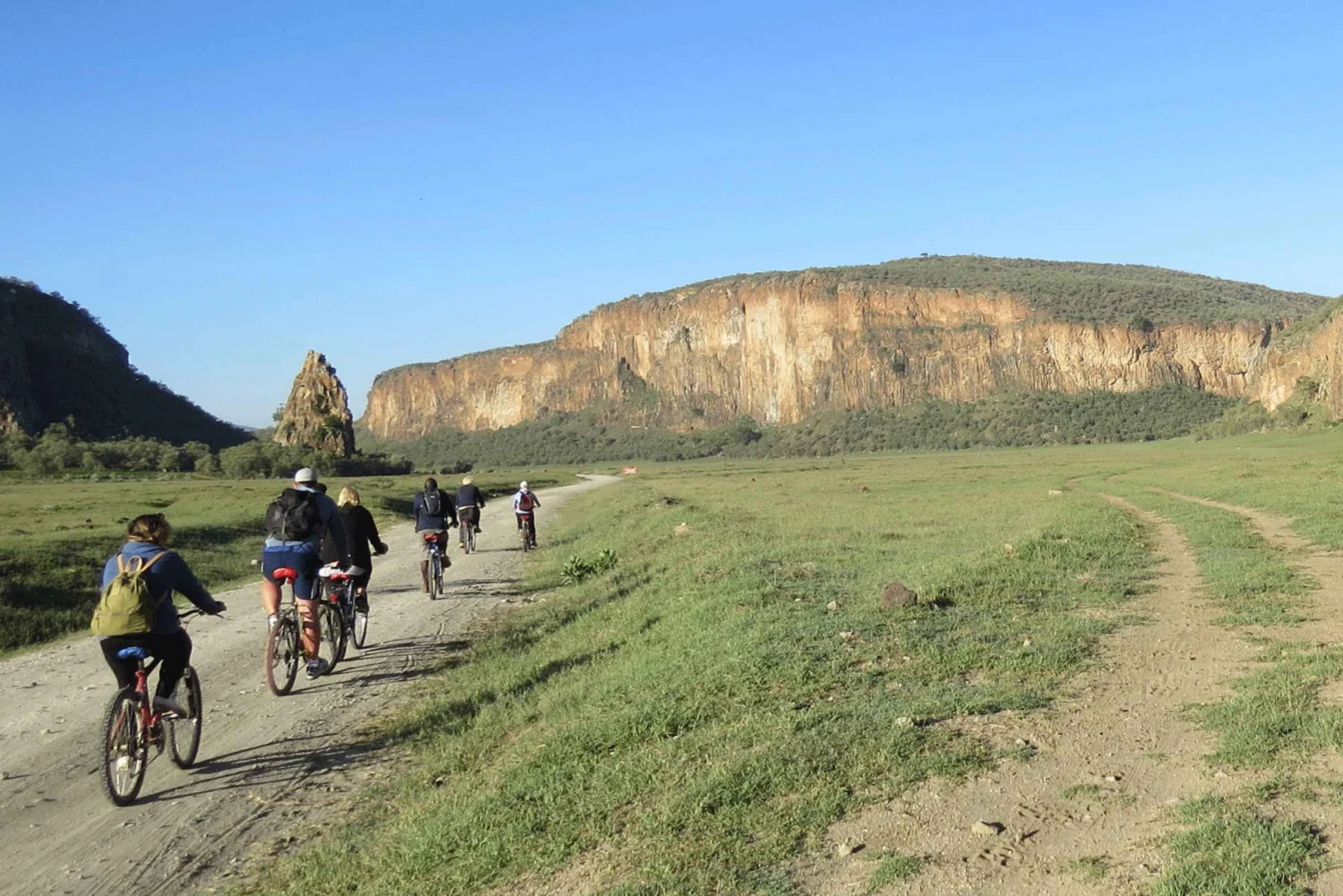
Renowned for its great hiking trails and biking among wildlife, Hellsgate is one of the favorite destinations for a weekend getaway. This 68sqkm park is only 101km from Nairobi city and sits right at the base of the Great Rift Valley.
The biggest attraction in Hells gate national park are the volcanic activities including hot geysers, hot springs and deep gorges. Although the gorges have been closed for a while now, they were the most scenic and awe-inspiring gulley’s that you could walk through. The devils kitchen was the highlight of these hikes deep into the bowels of the earth.
Angelina Jolie shot the tomb raiders- cradle of man-kind at these gorges while the lion king movie got its landscape inspiration from the cliffs and savannahs of the park.
Recently they have built the biggest spa pool in Africa in this park. The spa pool is fed with warm water from underground springs, which is therapeutic to swim in.
Best Time to Go: June to March
Top Attractions: Deep gorges, devils bedroom, red cliffs, hot springs, wildlife, bird watching, Mvuke geothermal spa pool,
Best Experiences: Hiking and wildlife, biking, swimming in therapeutic waters,
Accommodations to Stay & Eat: Naivasha Sopa lodge, Naivasha country club, Sawela lodge, Enashipai lodge, kongoni lodge, crayfish camp, Fisherman’s camp,
How to Get There: 20 minutes Flight from Nairobi r drive the 2 hours on naivasha road.
10. Mt Longonot National Park
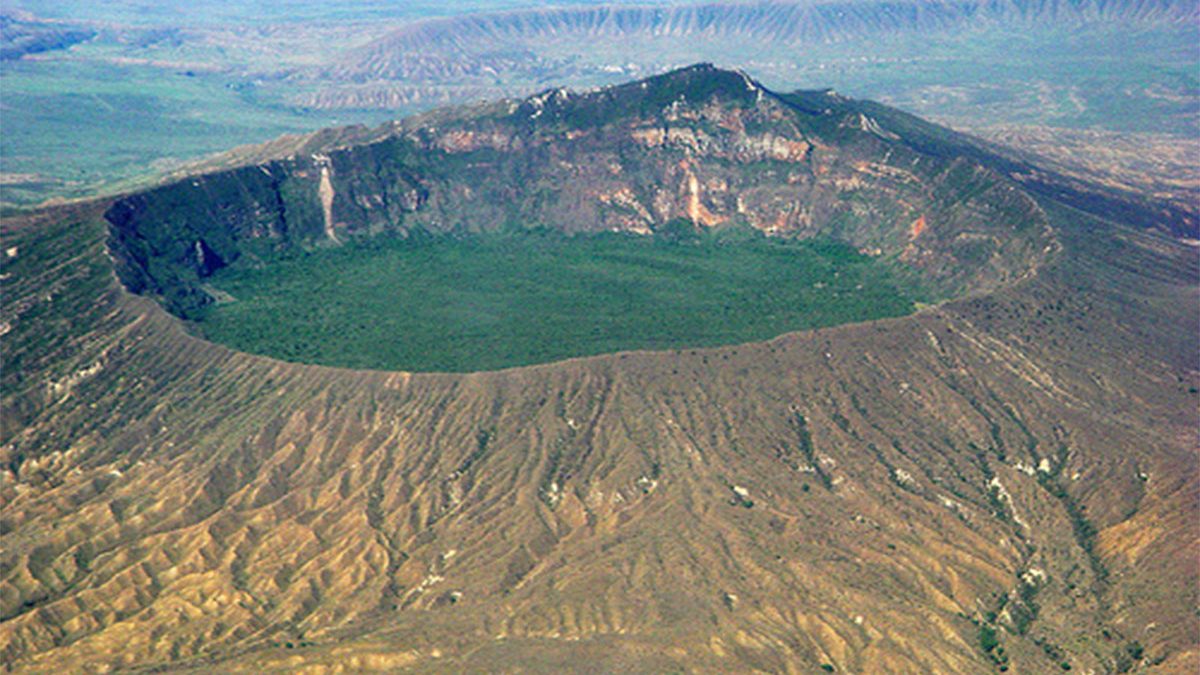
If you are into hiking steep slopes, then Mt Longonot is along your alley. Longonot National Park is located only 74km from Nairobi city. The park is famous for its challenging but short hiking trails and the most scenic crater views from the rim.
The full hike up to the rim, around the crater rim and back to gate is 9 km and takes 4-6 hours. Maximum elevation is 2780m above sea level and maximum elevation gain is 996m.
The view into Mt Longonot is so spectacular its worth all the effort to climb on all your fours to get there. The climb is steep in places but it’s generally a very doable hike. Most primary school kids have climbed the Mt Longonot so it’s of minimal difficulty.
Best Time to Go: July to February
Top Attractions: Mt longonot crater, hiking trail, buffalos and zebras on the trail, majestic views of the surrounding from the rim of the crater
Best Experiences: Hiking the 2776m mountain, Viewing the crater from the rim
Accommodations to Stay & Eat: Accommodations lodges in Naivasha or Nairobi city.
How to Get There: Drive the 1hr 30 minutes to the great rift valley floor where the mountain is located.
Find out more details about the top 10 national parks in Kenya, by WhatsApp on +254722661827 or email us on info@sojournsafaris.co.ke
